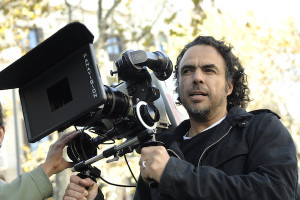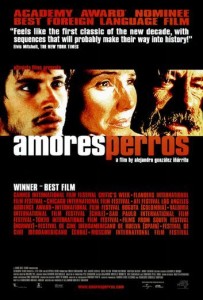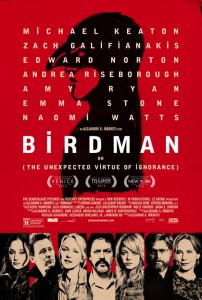Life & Death: Ranking the Films of Alejandro González Iñárritu
Most filmmakers spend the duration of a career emphasizing one walk of life over the infinite others, but occasionally there is an artist who seeks the truth through universality: the common thread that unifies a Mexican intersection, a Moroccan village, or an American theatre into a snapshot of what it truly means to be alive. Director Alejandro González Iñárritu is one such artist, pursuing the crevices of the human soul for nearly twenty 
Starting his own production company in the 1990s, the Mexico City native would spend much of the decade churning out advertisements and short films – many of which, including Detras del Dinero (1995) and El Timbre (1996), provided glimpses of the director’s penchant for humanized drama. But the small time status quickly came to a close with Amores Perros (2000), the feature length debut that made Iñárritu a star. Pairing with like-minded friends Alfonso Cuarón and Guillermo del Toro as “The Three Amigos of Cinema,” Iñárritu has since become a household international name.
Especially in the last few years, which has seen his U.S. stock raise tremendously on the back of Academy Awards and buzz worthy productions. Through it all, however, the director has maintained his reputation as “The Master of Melancholy.” Whether achieved through single takes, languishing imagery, or slicing quick cuts, these six films have embodied one of cinema’s most distinct resumes – for better or for worse. An Iñárritu production may not be easy, or even pleasant, to watch, yet there is an undeniable power that goes beyond the typical viewing experience.
Some filmmakers instill the idea that they capture life in its true essence, “the photograph of the photograph,” in the words of Stanley Kubrick. But Iñárritu’s beauty, horror, and spiritual approach to filling up film stock is second to none. Life & Death, Love & Pain, these are the films of Alejandro González Iñárritu.
6. 21 Grams (2003)
21 Grams, arriving three years after Amores Perros, brought the director’s ensemble storytelling to American audiences for the first time. But instead of toning down the bleak misery of his rookie film, Iñárritu cranked the torment levels up to ten for an experiment in onscreen mourning. This time, a car crash brings together the lives 
It echoes its predecessor in more ways than one, from the inciting incident to the nonlinear narrative. The editing is concise and engaging, offering just enough about each character to elicit maximum meaning. Iñárritu’s red soaked imagery assists in the anguish of his performers, who are spectacular in their respective roles; particularly Watts and del Toro, who earned Academy Award nominations for their work. Everything is present from a creative and performing standpoint, yet the film still lacks the punch that distinguishes its peers.
In a word, it lacks nuance. The title of the picture, referring to the amount of body mass lost in the moment of death, is meant to symbolize the human soul – but the heavy hand with which the story unfolds subsequently outweighs it. By tapping into a raw emotional nerve for 124 straight minutes, the director overloads his audience, and consequently undersells his technically flawless soufflé.
While 21 Grams finds Iñárritu diving headfirst into his worst tendencies, its importance in the auteur’s filmography is worth noting. As the second entry in his “Death Trilogy,” it allowed him to push the limits of the medium, finding just the right notes to return to and which to convey differently in future releases. A sophomore slump isn’t always a bad thing.
5. Biutiful (2010)
The sprawling flavors of Iñárritu’s ensemble work would ultimately shift towards intimate character studies, the first of which was 2010’s Biutiful. Returning to his native tongue for the first time in a decade, the film centers on Uxbal (Javier Bardem), a working class father who’s diagnosed with terminal prostate cancer. Between treatment options, professional corruption, and the struggle to make peace with his maker, Uxbal’s life progressively falls apart.

Though it bypasses the mind-numbing misery of 21 Grams, the film can occasionally find itself dipping into self-inflated melodrama, particularly the scenes between Uxbal and the mother of his children. Ultimately, however, the only indulgences on the part of Iñárritu are benefits to the purposely dense mood. A mood that comes to a crashing head when the gut-wrenching warehouse scene illustrates just how tragic death can truly be.
There aren’t too many movies that tackle mortality with such an unblinking embrace. Ironically, it was the project after Iñárritu’s “Death Trilogy” that best captured mankind’s obsession with its own demise. The bravery, the cowardice, the inevitability. Each stage is front and center in Biutiful, and like an illuminating angel, the director makes this journey one of existential expansion.
4. Babel (2006)
The most notable aspect of Babel is its scope. Encompassing four international stories simultaneously, the film hopscotches from the Middle East to the Neapolitan metropolis of Japan – in the process, providing a journey that unifies continents and cultures. Misery is in no short supply once again, as Iñárritu’s stock-in-trade style is splattered on a canvas of human compassion.

And while these sequences refuse to wince at the sight of circumstance, the director contrasts them with sparkling moments of bliss. The wedding of Amelia’s son rises to a swell of merengue and mariachi, sticking to the screen so sweetly it’s practically mouthwatering, while deaf/mute Chieko (Rinko Kikuchi) takes in the energy of a nightclub in all its pulsing silence. By contrasting the bounce of the nightclub speakers with the POV silence of her character, Iñárritu reaches a brilliant intimacy that requires a moment to fully take in.
Babel is to Iñárritu what Nashville (1975) is to Robert Altman; a grand mosaic of human interaction that’s confusing, frustrating, and ultimately indecisive about its future. One an absurd dramedy, the other an elaborate portrait, but both unapologetically romantic. Tellingly, Iñárritu dedicated the film to his children, whom he noted are “the brightest lights in the darkest night.” Those bright lights made him the first Latino director to earn an Academy Award nomination.
3. The Revenant (2015)
Knee deep in production hell and high turnover from crew, The Revenant takes its prize as the most ambitious undertaking of Iñárritu’s career. As the follow up to Birdman (2014), the director sought a project that pushed the very limits of physical storytelling – in the process, cementing his reputation as a modern day visionary.

The highly anticipated bear attack is stomach churning to witness, coming so close to legitimacy that it elicits quivers of mercy. DiCaprio, communicating solely through grunts of pain, as he does for much of the film, gives the performance of a lifetime. Through it all, Lubezki’s surgeon-like precision with the camera cascades through trees like an untouched ghost. And lastly, the showdown between Glass and his enemy is a snow white bloodbath; spraying chunks of flesh and blood across the icy blanket like a minimal Jackson Pollack. Mainstream cinema has rarely gotten this brutal.
Exemplified by the mention of these brilliant sequences, The Revenant is a collection of staggeringly powerful moments. But as a continuously engaging narrative, it comes and goes as it pleases, leaving it a hair short of perfection. Iñárritu, against the limitations of nature and weather, crafted a film that’s as much an achievement as it is a viewing experience.
2. Amores Perros (2000)
Lush with the creative energy that only a first time filmmaker provides, Amores Perros remains Iñárritu’s ultimate anthology film. It tells three separate stories, that of immature young man Octavio (Gael García Bernal), Spanish supermodel Valeria (Goya Toledo), and homeless hitman El Chivo (Emilio Echevarría) as their lives come together in a devastating car crash. Each from a different economic standing, but none above a brutal brush with death.

By simultaneously taking on the lower, middle, and upper class, the director tackles unpopular themes like capitalistic ideals and illegal activity – particularly dog fighting. As an element that drew much outcry for its brutal depictions, Iñárritu makes “man’s best friend” the true star of the film, incorporating them into each corner of this cinematic triptych. That these pure animals ultimately suffer at the hand of man’s betrayal and impurity is a statement that winds up stinging far deeper than any political commentary.
Amores Perros remains the first, and best, of the director’s “Death Trilogy.” Future installments would seek the truth by expanding its scope or increasing its tone, but there’s a magic to this initial presentation that maintains its luster even fifteen years later. Perhaps it’s the passionate style or the fearless observation. Whatever the case, Perros takes its rightful place as one of cinema’s greatest directorial debuts.
1. Birdman or (The Unexpected Virtue of Ignorance) (2014)
Riggan Thomson (Michael Keaton) is a washed up action star who decides to make a final stab at stardom with a self-directed Broadway play. In one fell swoop, he welcomes in the mockery of Hollywood, the scorn of his family, and the inner monologue of a man desperately seeking a legacy. Death, while a hovering reminder of the inevitable, takes a back seat to the issues posed by remaining alive. The depraved bleakness of Iñárritu projects past also ease up in favor of dimly lit satire and recurring tighty whities. Put simply, Birdman, the witty black sheep of the director’s sheared resume, is one of the best films of the 21st century.

Collaborating with Cuarón cinematographer Emmanuel Lubezki, both men construct a meticulous series of single takes that capture Thomson’s frantic mindset. Cleverly concealed edits give the illusion of a 119 minute take, pushing both the technical and creative boundaries of modern cinema to their fullest potential. In executing his story with such zeal, Iñárritu captures a jazz session of words and pictures, culminating in a finale that ranks as his most outlandishly ambiguous.
Iñárritu wound up winning big with Birdman’s release, netting Best Picture, Best Director, and Best Original Screenplay for his brilliant work. In a rare example of the Academy getting it right, it solidified the auteur as one of today’s moviemaking giants. Whether this perfect blend of humor and drama will find its way into future films remains to be seen; but, as it stands, Birdman is Alejandro González Iñárritu’s masterpiece.



Latest posts by Danilo Castro (see all)
- The 20 Best Detective Movies of All Time - February 16, 2016
- Life & Death: Ranking the Films of Alejandro González Iñárritu - January 6, 2016
- Evolution of a Champ: The Rocky Film Saga - November 25, 2015


